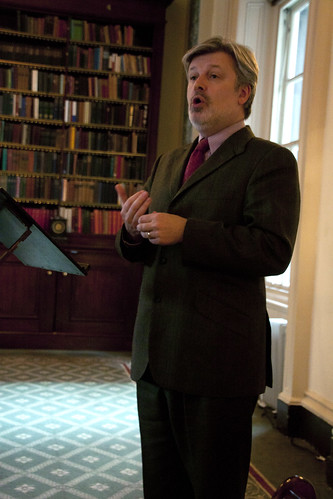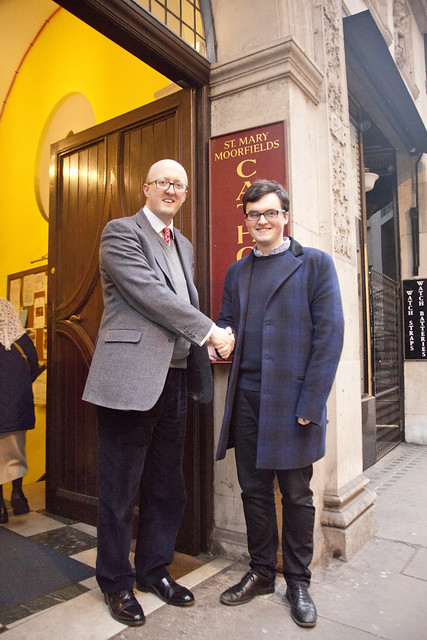 |
| James Gillick's impressive reredos for SS Gregory and Augustine's, Oxford |
In the end, I left the Catholic Church because as an artist I could no longer hold out hope that there would be a place for me in the church. The Catholic Church, which gave the world the Sistine Chapel, Dante, and the genius filmmaker Robert Bresson, has lost interest in supporting artists. God is a dynamic and creative universal force who can be found in movies, rock and roll, and poetry.
...
What I was not prepared for is how negative, obstructionist, and soul-crushing the church has become when it comes to art. I have asked prominent Catholic scholars and theologians why the Catholic Church has no foundation, think tank, fellowship or even website for the study of popular culture. St. Augustine wrote entire volumes about paganism, and in doing so managed to baptize millions of new converts. Surely something, perhaps a single fellowship at a Catholic think tank, might not be a bad idea?
This is a pretty dreadful justification for leaving the Church, but it is, nonetheless, a motivation for doing so which tells us something about the state of the Church. Judge is right that the Church has a serious problem today in relation to art, even if it is unfair to say that no one in the Church is interested in creating, discussing, or promoting art.
One problem in the Church is with what we might call 'fine' art: not very much art of the highest standards, art which could be compared to the work of the masters of past generations or the most respected practioners of today, is being done within or for the Church. But the news isn't all bad. A lot of 'fine art', high-brow art, being done today is peculiarly ill suited to devotional or liturgical use - the unmade beds and so on - and this limits the kind of involvement the Church can be expected to have. Nonetheless, there are areas of the artistic world where the collapse of Western culture and the distorting effects of public sponsorship have not totally destroyed the skills and the traditions. Examples are literature, music, and, within painting, portraiture. We do find good Catholic artists at work here, producing art for the Church as well as for others. They are even involved in efforts to maintain their traditions and pass them on to future generations. The Latin Mass Society has two composers among its Patrons, Colin Mawby and James MacMillan, who in different ways are involved in promoting Catholic music; have a look here at what the painters James Gillick and David Clayton are doing; Catherine Goodman is the Artistic Director of the Prince of Wales' Drawing School.
Catholic writers also exist; their work has never had the same connection with Church patronage and support as other forms of art so the problem here is less acute.
Apart from the odd commission, however, these artists get very little help and support from the bishops or Catholic institutions like schools and colleges. Why have James MacMillan and David Clayton, for example, had to set up their own organisations to promote forms of art absolutely central to Catholic culture? Bishops and Catholic grant-making bodies don't appear to be interested in fine art. There seems to be an embarassment about it; a lot of people appear to have accepted the peculiar argument that fine art is elitist - that it doesn't speak to 'ordinary people'. It is a peculiar argument because it is evidently false: fine music and paintings and literature have been used to get the Catholic message across to the masses from their very beginnings. Stained glass windows and wall paintings in churches, liturgical music, the Mystery Plays: they were used precisely because they communicated with masses of people who couldn't or wouldn't study theology or read books of sermons.
 |
| James MacMillan address the Gregorian Chant Network, which is sponsored by the Latin Mass Society |
What we do find is isolated Catholics making the occasional film of spiritual interest: The Passion of the Christ is the outstanding example, even if Mel Gibson is not an outstanding example of a Catholic. And then we have people at EWTN and its imitators making lots of films, on hidiously tight budgets and often with very limited training. This is a lot better than nothing, and the Latin Mass Society has even sponsored one of these projects. It is no criticism of those doing this to observe that their output isn't going to break through to the mainstream any time soon. I can't think of any other area of popular art - such as graphic art or popular music - where even this much can be said. (Admittedly my knowledge of pop music is pretty limited, and if readers know Catholic pop musicians whose work is informed by their faith I'd be interested to hear more in the comm box.)
The bishops and the rest of the 'Catholic establishment' seem even less interested in Catholic popular art than they are in Catholic fine art. This is pretty amazing, given the argments used against the fine art, but the reality is that there is a little clique of officially-approved composers who have cornered the market in Catholic liturgical music in different countries, who are capable of producing music, if it can be called music, which is neither fine nor, in any genuine sense, popular. It is not part of the tradition of the Church's musical patrimony, and it does not have anything to say to modern popular styles either. It is just forgettable, and forgetting it is the kindest thing, probably, that we can do.
If too many bishops and trustees of Catholic grant-making bodies have an inverted snobbery about fine art, I get the impression that they are simply terrified of popular art. They sense, rightly, that popular art is even more elitist than fine art: it has produced its own artistocracy, after all. They sense, rightly, that a lot of it is hostile to the Faith. Their response has been to refuse to engage with it.
Were Catholics to attempt to engage with popular art, this engagement should obviously not simply be a matter of embracing it. It has to be done with artistic and theological sensitivity. We had a bit of debate about fantasy literature over the Harry Potter books and Tolkein not long ago, and it really showed up how little theological or artistic sophistication we were able to call on to address the issues. At least there are a handful of books about it. On the genre of Rock music, we haven't even got that far.
Vatican II called on Catholics to engage with the world. To an amazing extent, the response of the Catholic establishment, the Church's intellectual leadership, has been to engage with the world, on a cultureal level, much less than ever before. Their position oscilates between accepting without any thought the things which seem to be impossible to resist, and ignoring it in the hope that it will go away.
It isn't going away. The least we have to do is to have a serious critique of it. In the meantime, we can expect more artists like Mark Judge to give up on the Church in despair.
See also my series of posts on Harry Potter, and my series on Mediocrity.
 |
| The winner of a prize for a new composition of a Latin liturgical text, sponsored by the Latin Mass Society: Marco Galvani (right), with the creator of the prize, Matthew Schellhorn |
No comments:
Post a Comment